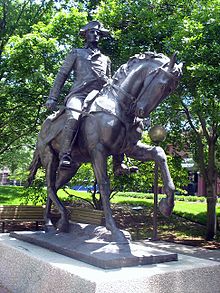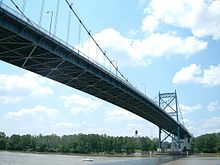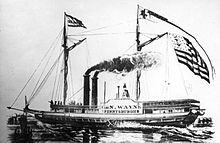- Anthony Wayne
-
For other uses, see Anthony Wayne (disambiguation).
Anthony Wayne 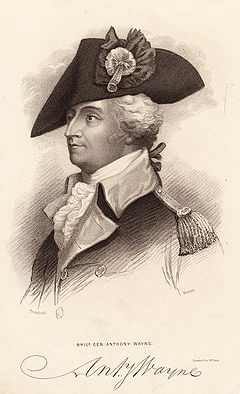
Nickname Mad Anthony Born January 1, 1745
Easttown Township, PennsylvaniaDied December 15, 1796 (aged 51) Buried at Fort Presque Isle (now Erie, Pennsylvania) Allegiance  United States of America
United States of AmericaYears of service 1775-1783
1792-1796Rank  Colonel 1775-1777
Colonel 1775-1777
 Brigadier General 1777-1783
Brigadier General 1777-1783
 Major General 1783; 1792-1796
Major General 1783; 1792-1796Battles/wars American Revolutionary War
Battle of Trois-Rivières
Battle of Brandywine
Battle of Paoli
Battle of Germantown
Battle of Monmouth
Battle of Stony Point
Battle of Green Spring
Northwest Indian War
Siege of Fort Recovery
Battle of Fallen TimbersAnthony Wayne (January 1, 1745 – December 15, 1796) was a United States Army general and statesman. Wayne adopted a military career at the outset of the American Revolutionary War, where his military exploits and fiery personality quickly earned him a promotion to the rank of brigadier general and the sobriquet of Mad Anthony.
Contents
Early life
Wayne was one of five children born to Isaac Wayne and Elizabeth Eddings Wayne on the family farm in Easttown Township, near present-day Paoli, Chester County, Pennsylvania. He was educated as a surveyor at his uncle's private academy in Philadelphia, as well as at the College of Philadelphia (now the University of Pennsylvania), where he was in the class of 1765, although he did not earn a degree. In 1766 he was sent by Benjamin Franklin and some associates to work for a year surveying land they owned in Nova Scotia and assisting with starting settlements there. In 1767 he returned to work in his father's tannery, while continuing work as a surveyor. He became a prominent figure in Chester County and served in the Pennsylvania legislature from 1774–1780. He married Mary Penrose in 1766 and they had two children. Their daughter Margretta was born in 1770 and their son Isaac Wayne, future U.S. Representative from Pennsylvania, was born in 1772.[1]
American Revolution
At the onset of the war in 1775, Wayne raised a militia unit and, in 1776, became colonel of the 4th Pennsylvania Regiment. He and his regiment were part of the Continental Army's unsuccessful invasion of Canada where he was sent to aid Benedict Arnold, during which he commanded a successful rear-guard action at the Battle of Trois-Rivières, and then led the distressed forces at Fort Ticonderoga. His service resulted in a promotion to brigadier general on February 21, 1777.
Later, he commanded the Pennsylvania Line at Brandywine, Paoli, and Germantown. After winter quarters at Valley Forge, he led the American attack at the Battle of Monmouth. During this last battle, Wayne's forces were pinned down by a numerically superior British force. However, Wayne held out until relieved by reinforcements sent by Washington. This scenario would play out again years later, in the Southern campaign.
The highlight of Wayne's Revolutionary War service was probably his victory at Stony Point. In July 1779 Washington named Wayne to command the Corps of Light Infantry, a temporary unit of four regiments of light infantry companies from all the regiments in the Main Army. On July 16, 1779, in a bayonets-only night attack lasting thirty minutes, three columns of light infantry, the main attack personally led by Wayne, stormed British fortifications at Stony Point, a cliffside redoubt commanding the southern Hudson River. The success of this operation provided a boost to the morale of an army which had at that time suffered a series of military defeats. Congress awarded him a medal for the victory.
On January 1, 1781, Wayne, then the commanding officer of the Pennsylvania Line of the Continental Army, was faced with a mutiny over pay and conditions that was one of the most serious of the war. The mutiny was successfully resolved by dismissing about one half of the line, which Wayne then had to rebuild. This work was largely completed by May 1781, but it delayed his departure to Virginia, where he had been sent to assist the Marquis de Lafayette against British forces operating there. The line's departure was delayed once more when the men again complained about being paid in the nearly-worthless Continental currency.
In Virginia, Wayne led Lafayette's advance forces in an action at Green Spring, where he led a bayonet charge against the numerically superior British forces after stepping into a trap set by Charles Cornwallis. This increased his popular reputation as a bold commander. After the British surrendered at Yorktown, he went further south and severed the British alliance with Native American tribes in Georgia. He then negotiated peace treaties with both the Creek and the Cherokee, for which Georgia rewarded him with the gift of a large rice plantation. He was promoted to major general on October 10, 1783.
Political career
 Statue of Wayne at Valley Forge
Statue of Wayne at Valley Forge
After the war, Wayne returned to Pennsylvania and served in the state legislature for a year in 1784. He then moved to Georgia and settled upon the tract of land granted him by that state for his military service. He was a delegate to the state convention which ratified the United States Constitution in 1788.
In 1791, he served a year in the Second United States Congress as a U.S. Representative of Georgia but lost his seat during a debate over his residency qualifications and declined to run for re-election in 1792.[2]
President George Washington recalled Wayne from civilian life in order to lead an expedition in the Northwest Indian War, which up to that point had been a disaster for the United States. Many American Indians in the Northwest Territory had sided with the British in the Revolutionary War. In the Treaty of Paris that had ended the conflict, the British had ceded this land to the United States. The Indians, however, had not been consulted, and resisted annexation of the area by the United States. The Western Indian Confederacy achieved major victories over U.S. forces in 1790 and 1791 under the leadership of Blue Jacket of the Shawnees and Little Turtle of the Miamis. They were encouraged and supplied by the British, who had refused to evacuate British fortifications in the region as called for in the Treaty of Paris.
Washington placed Wayne in command of a newly-formed military force called the "Legion of the United States". Wayne established a basic training facility at Legionville to prepare professional soldiers for his force. Wayne's was the first attempt to provide basic training for regular U.S. Army recruits and Legionville was the first facility established expressly for this purpose.
He then dispatched a force to Ohio to establish Fort Recovery as a base of operations. On August 3, a tree fell on Wayne's tent. He survived, but was rendered unconscious. By the next day, he had recovered sufficiently to resume the march.[3] On August 20, 1794, Wayne mounted an assault on the Indian confederacy at the Battle of Fallen Timbers, in modern Maumee, Ohio (just south of present-day Toledo), which was a decisive victory for the U.S. forces, ending the war. Wayne then negotiated the Treaty of Greenville between the tribal confederacy and the United States, which was signed on August 3, 1795. The treaty gave most of what is now Ohio to the United States, and cleared the way for that state to enter the Union in 1803.
Wayne died of complications from gout on December 15, 1796 during a return trip to Pennsylvania from a military post in Detroit, and was buried at Fort Presque Isle (now Erie, Pennsylvania) where the modern Wayne Blockhouse stands. His body was disinterred in 1809 and, after boiling the body to remove the remaining flesh, as many of the bones as would fit in two saddlebags were relocated to the family plot in St. David's Episcopal Church cemetery in Radnor, Pennsylvania.[4] A legend says that many bones were lost along the roadway that encompasses much of modern U.S. Route 322, and that every January 1 (Wayne's birthday), his ghost wanders the highway searching for his lost bones.
Legacy
On September 14, 1929 the US Post office issued a stamp honoring General Wayne and which commemorated the 150th anniversary of the Battle of Fallen Timbers. The post office issued a series of stamps often referred to as the 'Two Cent Reds' by collectors, issued to commemorate the 150th Anniversaries of the many events that occurred during the American Revolution and to honor people such as General Wayne and those others who were there during these times of struggle.
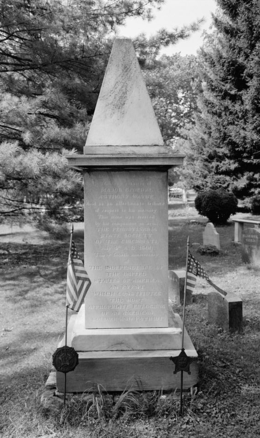 His grave at St. David's.
His grave at St. David's.
Municipalities and institutions
There are many political jurisdictions and institutions named after Wayne, especially in Ohio, Michigan, and Indiana, the region where he fought many of his battles.
Boroughs
- The Borough of Waynesboro, Pennsylvania
- The Borough of Waynesburg, Pennsylvania
Businesses, structures
- The former Anthony Wayne Bank in Fort Wayne
- Anthony Wayne Barber Shop in Maumee, Ohio
- Anthony Wayne, a campsite at Woodland Trails Scout Reservation in Camden, Ohio
- The Anthony Wayne Movie Theater in Wayne, Pennsylvania
- Anthony Wayne Recreation Area in Harriman State Park, New York
- AWS, formerly Anthony Wayne Rehabilitation Center for the Handicapped and Blind, Inc. in Fort Wayne, Indiana
- Anthony Wayne Restaurant, defunct, in Wayne, New Jersey
- Anthony Wayne Suspension Bridge near downtown Toledo, Ohio
- Anthony Wayne Terrace Housing Association Baden, Pennsylvania
- Mad Anthony Brewing Company, in Fort Wayne, Indiana
- Fort Wayne in Fort Wayne, Indiana
- Fort Wayne in Detroit, Michigan
- General Wayne Inn in Merion, Pennsylvania
- "Mad Anthony's", a local pub in Waterville, Ohio, is named after Anthony Wayne
- Wayne Corporation defunct school bus manufacturer, originally Wayne Agricultural Works, then Wayne Works
- Wayne Hospital in Greenville, Ohio
- Anthony Wayne Hotel in Akron, Ohio, demolished in 1996
Cities
- The City of Fort Wayne, Indiana
- The City of Wayne, Michigan
- The City of Wayne, Nebraska
- The City of Waynesboro, Georgia
- The City of Waynesboro, Mississippi
- The City of Waynesboro, Tennessee
- The City of Waynesboro, Virginia
- The City of Wayne, New Jersey
Communities
- The community of Wayne, Pennsylvania
- The community of Waynedale, Fort Wayne, Indiana
Counties
- Wayne County, Illinois
- Wayne County, Indiana
- Wayne County, Iowa
- Wayne County, Kentucky
- Wayne County, Georgia
- Wayne County, Michigan
- Wayne County, Mississippi
- Wayne County, Missouri
- Wayne County, Nebraska
- Wayne County, New York
- Wayne County, North Carolina
- Wayne County, Ohio
- Wayne County, Pennsylvania
- Wayne County, Tennessee
- Wayne County, West Virginia
Forests
- Wayne National Forest in Ohio
Towns
- The Town of Wayne, New York
- The Town of Wayne, Oklahoma
- The Town of Waynesville, Missouri
- The Town of Waynesville, North Carolina
- The Town of Wayne, New Jersey
Rivers
- the Mad River, a tributary of the Great Miami River, Dayton, Ohio
Schools
- Anthony Wayne Elementary School in Defiance, Ohio
- Anthony Wayne Elementary School in Franklin, Ohio
- Anthony Wayne Middle School in Wayne, New Jersey
- Anthony Wayne School District, Ohio, whose sports teams are known as the "Fighting Generals".
- General Wayne Elementary School, in Malvern, Pennsylvania
- Wayne County High School, in Monticello, Kentucky
- Wayne Community Schools in Corydon, Iowa
- Wayne County Community College in Detroit, Michigan
- Wayne Elementary School Erie, Pennsylvania
- Wayne High School, Huber Heights, Ohio
- Wayne High School (Oklahoma), Wayne, Oklahoma
- Wayne High School, Fort Wayne, Indiana
- Wayne State College, Wayne, Nebraska
- Wayne State University, Detroit
- Waynesboro High School in Waynesboro, Virginia
- Waynesburg University in Waynesburg, Pennsylvania
- Waynesfield-Goshen Schools, Waynesfield, Ohio
Streets and Highways
- Anthony Boulevard, Fort Wayne, Indiana
- Anthony Wayne Avenue, Cincinnati, Ohio
- (Anthony) Wayne Avenue, Ticonderoga, New York
- Anthony Wayne Drive, in Detroit, Michigan
- Anthony Wayne Drive, in Baden, Pennsylvania
- Anthony Wayne Drive, in Chesterbrook, Pennsylvania
- Anthony Wayne Drive, Warminster, Pennsylvania
- Anthony Wayne Trail, in Toledo, Ohio
- Anthwyn Road, Merion, Pennsylvania (across from the inn)
- Mad Anthony Street, Cincinnati, Ohio
- Mad Anthony Street, Millersburg, Ohio
- North Wayne Avenue in Lockland, Ohio
- South Wayne Avenue, Fort Wayne, Indiana
- South Wayne Avenue in Lockland, Ohio
- Southwest Anthony Wayne Drive, Fort Wayne, Indiana
- Wayne Avenue, Bronx, New York
- Wayne Avenue, Chicago, Illinois[5]
- Wayne Avenue, Dayton, Ohio
- Wayne Avenue (Rte 112), Stony Point, New York
- Wayne Avenue, Philadelphia, Pennsylvania
- Wayne Street, Fort Wayne, Indiana
- Wayne Street, Toledo, Ohio
- Wayne Trace, Fort Wayne, Indiana
- Mad River Road, in Hillsboro, Ohio
 This flag, presented to Miami chief She-Moc-E-Nish at the Treaty of Greenville, is signed "A.Wayne commander in chief".[6] It is currently owned by the State of Indiana[7]
This flag, presented to Miami chief She-Moc-E-Nish at the Treaty of Greenville, is signed "A.Wayne commander in chief".[6] It is currently owned by the State of Indiana[7]
Townships
- Wayne Township, Illinois
- Wayne Township, Allen County, Indiana
- Wayne Township, Indianapolis, Indiana
- The former Wayne Township, Montgomery County, Ohio (now the City of Huber Heights)
- Wayne Township, New Jersey
- Wayne Township, Lawrence County, Pennsylvania
- the former Mad River Township and Mad River Township Local School District (now Riverside, Ohio)
Villages
- The Village of Wayne, Illinois
- The Village of Waynesfield, Ohio
- The Village of Waynesville, Illinois
- The Village of Waynesville, Ohio
- The Village of Wayne City, Illinois
- The Village of Waynesburg, Ohio
Popular culture
Wayne's legacy has extended to American popular culture in a number of ways.
In literature and publications
(alphabetized by author)
- Wayne is mentioned in Donald Barthelme's novel, The King.
- Contrary to the popular belief that Bruce Wayne (the real name of the superhero character Batman) was named after John Wayne, comic book writer Bill Finger named Batman's alter ego after Robert the Bruce and Anthony Wayne. In the DC Comics, Bruce Wayne is depicted as General Wayne's direct descendant. Furthermore, the property on which Wayne Manor is built was given to General Wayne for his service during the Revolution. Rumours that Bruce's middle name is "Anthony" have yet to be confirmed by DC Comics.
- In F. Scott Fitzgerald's Tender Is the Night (1934), Dick Diver mentions his descent from Mad Anthony Wayne.
- Anthony Wayne is one of the main characters in Ann Rinaldi's historical novel, A Ride into Morning.
- In J.D. Salinger's The Catcher in the Rye (1951), Mr. Spencer, one of the teachers at (fictitious) Pencey Prep School, lives across the street from campus on Anthony Wayne Avenue.
In products
- Mad Anthony Ale (Mad Anthony's APA), an American Pale Ale (APA) brewed by the Erie Brewing Companyin Erie, Pennsylvania
Onscreen
- Actor Marion Robert Morrison was initially given the stage name of Anthony Wayne, after the general, by Raoul Walsh, who directed The Big Trail (1930), but Fox Studios changed it to John Wayne instead, saying "Anthony" sounded "too Italian". John Wayne was leading man in 142 of his 153 movies, more than any other actor in history.[citation needed]
- In "Guy Walks Into a Psychiatrist's Office...", the Season Two premiere of The Sopranos, the character Dr. Jennifer Melfi is shown seeing patients at the "Anthony Wayne Motel" in Wayne, New Jersey while on the lam, in fear for her life.
- The 1971 made-for-tv movie "Assault on the Wayne" starring Leonard Nemoy takes place on board the submarine "U.S.S Anthony Wayne".
In sculpture
 Wayne County Building pediment
Wayne County Building pediment
- The Wayne County Building in Detroit, Michigan features a pediment by Edward Wagner that depicts an equestrian Wayne.
- Battle of Fallen Timbers Monument also known as the Anthony Wayne Monument, Maumee, Ohio, 1929
In transportation
- The Gen. "Mad" Anthony Wayne, a side-wheel steamboat, sank in April 1850 in Lake Erie while en route from the Toledo, Ohio area to Buffalo, New York. 38 out of 93 passengers and crew on board died. On June 21, 2007, it was announced that the wreck had been discovered by Thomas Kowalczk, an amateur shipwreck hunter.[8]
- Major General Anthony Wayne, U.S. Army tugboat based at Southampton, UK
Other uses
- The Mad Ants basketball team represents Ft. Wayne, Indiana in the NBA Development League.[9]
- In 1987, artist Mark Cline lobbied the Waynesboro, Virginia city council to erect a 60 ft (18 m) bust of "Mad" Anthony Wayne atop the city's capped landfill.[10]
Notes
- ^ Anthony and Mary (Penrose) Wayne Family Bible http://genealogycenter.info/bibles/viewbiblepage_wayneanthony.php?p=10
- ^ United States Congressional Elections, 1788–1997: The Official Results confirms the seat was declared vacant on March 21, 1792.
- ^ Carter, 133
- ^ Hugh T. Harrington and Lisa A. Ennis. "Mad" Anthony Wayne: His Body Did Not Rest in Peace. http://www.americanrevolution.org/wayne.html, citing History of Erie County, Pennsylvania, vol. 1. pp. 211-2. Warner, Beers & Co., Chicago. 1884.
- ^ "Chicago Streets". http://www.chsmedia.org/househistory/nameChanges/start.pdf. Retrieved 2011-08-15.
- ^ Furlong, William Rea; McCandless, Byron (1981). So Proudly We Hail : The History of the United States Flag. Washington, D.C.: Smithsonian Institution Press. p. 160. ISBN 0-87474-448-2.
- ^ Anthony Wayne Flag (Greenville Treaty Flag)
- ^ Lafferty, Mike (2007-06-21). "Lake Erie searchers locate 157-year-old shipwreck". Columbus Dispatch. http://www.dispatch.com/live/content/local_news/stories/2007/06/21/wreck.ART_ART_06-21-07_A1_3072T13.html. Retrieved 2008-04-29.
- ^ Fort Wayne in the NBA Development League
- ^ Gonzalez, Tony (2009-04-01). "Epic Return". The News Virginian.
References
- Allen, William B. (1872). A History of Kentucky: Embracing Gleanings, Reminiscences, Antiquities, Natural Curiosities, Statistics, and Biographical Sketches of Pioneers, Soldiers, Jurists, Lawyers, Statesmen, Divines, Mechanics, Farmers, Merchants, and Other Leading Men, of All Occupations and Pursuits. Bradley & Gilbert. pp. 46–47. http://books.google.com/books?id=s_wTAAAAYAAJ. Retrieved 2008-11-10.
- Carter, Harvey Lewis. The Life and Times of Little Turtle: First Sagamore of the Wabash. ©1987, Urbana: University of Illinois Press. ISBN 0-252-01318-2.
- Dubin, Michael J. United States Congressional Elections, 1788–1997: The Official Results of the Elections of the 1st through 105th Congresses. Jefferson, N.C.: McFarland and Company, 1998. ISBN 0-7864-0283-0.
- Knopf, Richard C. [editor] Anthony Wayne: A Name in Arms (Pittsburgh: University of Pittsburgh Press, 1960).
- Pleasants, Henry; Delaware County Historical Society (1907). History of Old St. David's Church Radnor, Delaware County, Pennsylvania. John C.Winston Co. p. 206. http://books.google.com/books?id=KlQVAAAAYAAJ&pg=PA1&dq#v=onepage&q=&f=false.
External links
- Anthony Wayne and the Battle of Fallen Timbers from The Army Historical Foundation
- General Anthony Wayne
- Anthony Wayne family papers. WIlliam L. Clements Library.
- National Park Service Museum Collection: American Revolutionary War Exhibit, Wayne portrait & bio
- Maumee Valley Heritage Corridor
- Anthony Wayne - The Man Buried in Two Places
- "The Man Buried in Two Places", Chester County Genealogy, 2007/7/10
- Gen Anthony Wayne @ Find A Grave (bones)
- Gen Anthony Wayne @ Find A Grave (flesh)
United States House of Representatives Preceded by
James Jackson (politician)Member of the U.S. House of Representatives
from Georgia's 1st congressional district
March 4, 1791– March 21, 1792Succeeded by
John MilledgeMilitary offices Preceded by
Arthur St. ClairSenior Officer of the United States Army
1792–1796Succeeded by
James WilkinsonLeaders of the United States ArmySenior Officer /
Commanding General

Chiefs of Staff Young · Chaffee · Bates · Bell · Wood · Wotherspoon · Scott · Bliss · March · Pershing · Hines · Summerall · MacArthur · Craig · Marshall · Eisenhower · Bradley · Collins · Ridgway · Taylor · Lemnitzer · Decker · Wheeler · Johnson · Westmoreland · Palmer · Abrams · Weyand · Rogers · Meyer · Wickham · Vuono · Sullivan · Reimer · Shinseki · Schoomaker · Casey · Dempsey · OdiernoVice Chiefs of Staff Categories:- 1745 births
- 1796 deaths
- Congressional Gold Medal recipients
- Continental Army generals
- Continental Army officers from Pennsylvania
- History of Fort Wayne, Indiana
- Members of the United States House of Representatives from Georgia (U.S. state)
- Members of the Pennsylvania House of Representatives
- People of Pennsylvania in the American Revolution
- American people of the Northwest Indian War
- United States Army generals
- Wayne County, Georgia
- Wayne County, Illinois
- Wayne County, Indiana
- Wayne County, Michigan
- Wayne County, North Carolina
- Wayne County, Ohio
- Wayne County, West Virginia
- Members of the Society of the Cincinnati
Wikimedia Foundation. 2010.

